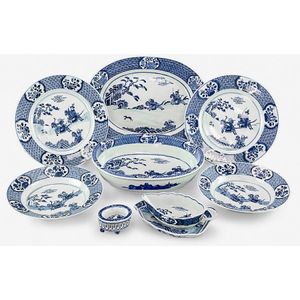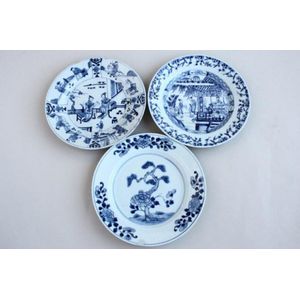Royal Worcester Forget-Me-Not Baluster Jug with Wedgwood Soup Bowl
You must be a subscriber, and be logged in to view price and dealer details.
Subscribe Now to view actual auction price for this item
When you subscribe, you have the option of setting the currency in which to display prices to $Au, $US, $NZ or Stg.
- Transfer Printed / Decorated Transferware - Transfer printing is method of decorating ceramics, reducing the cost of decoration when compared to employing artists to paint each piece. A print was taken on transfer-paper from an engraved copperplate, covered in ink prepared with metallic oxides, and the image on the paper was then applied to the biscuit-fired ceramic body. The print was fixed by heating the object in an oven, and then glazed, sealing the picture. Early transfer prints were blue and white, as cobalt was the only colour to stand firing without blurring. Early in the 19th century advances in the composition of the transfer paper resulted in better definition and detail, and enabled engravers to combine line-engraving with stipple.
- Firing Crack - A firing crack is a crack in a porcelain or stoneware item that occurs whilst the item is in the kiln.They are usually caused by faulty design, where one part is thicker than the surrounding area, and being thicker it cools more slowly, setting up a stress with the surrounding area. Firing cracks are not often seen on modern mass produced porcelain, as the damaged items are discarded during prooduction. However they are seen in earlier items and artisan-produced objects.
- Gilding - Gilding is a method of ornamentation whereby a thin sheet of gold metal is applied to items made of wood, leather, ceramics, glass and silver for decorative purposes.
For furniture including mirrors, the sheet of gold is usually applied over a coating of gesso. Gesso is a mixture of plaster of Paris and gypsum mixed with water and then applied to the carved wooden frames of mirrors and picture frames as a base for applying the gold leaf. After numerous coats of gesso have been applied, allowed to dry and then sanded a coat of "bole", a usually red coloured mixture of clay and glue is brushed on and allowed to dry, after which the gold leaf is applied. Over time parts of the gilding will rub off so the base colour can be seen. In water gilding, this was generally a blue colour, while in oil gilding, the under layer was often yellow. In Victorian times, gilders frequently used red as a pigment beneath the gold leaf.
Metal was often gilded by a process known as fire gilding. Gold mixed with mercury was applied and heated, causing the mercury to evaporate, the long-term effect of which was to kill or disable the craftsman or woman from mercury poisoning. The pursuit of beauty has claimed many victims, not the least of which were the artists who made those pieces so highly sought after today.
This item has been included into following indexes:
-
Royal Worcester (England), item types
- jugs & ewers 335
- plates 575
Visually similar items

Chinese export Kangxi-style blue and white partial dinner service, 19th century, including: seven dinner plates, fourteen side plates, two large plates, four deep plates, eight soup plates, one tureen, three graduated oval platters, one gravy boat, one spo

Crown Lynn, Cook Bicentenary Plate 1769-1969, City of Gisborne (ed of 2000) together with Dorothy Thorpe Santa Barbara saucer (2)

Three Chinese Qing Dynasty blue and white porcelain plates, one decorated with tree, flowers and foliage, two decorated with figures at work and play, a/f, diameter 23 cm, (3)

A Chinese blue and white Kraak style dish and four other blue and white dishes, 21 to 15 cm diameter
